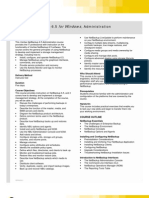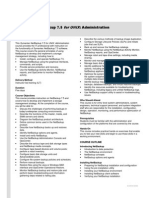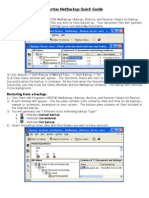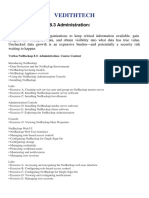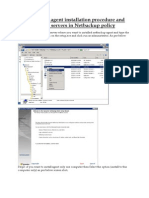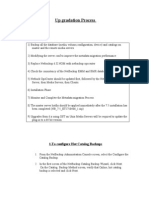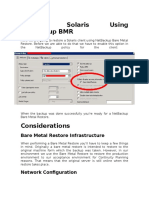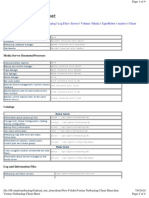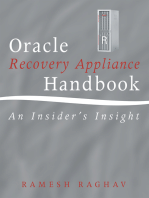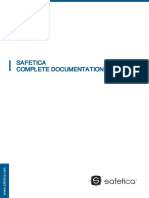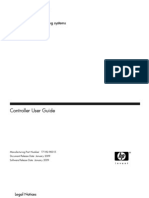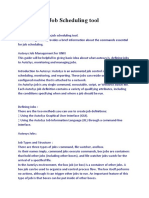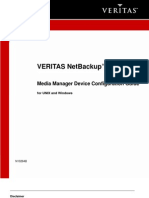Nbu82 Admin Les05
Uploaded by
Christopher MeyerweckNbu82 Admin Les05
Uploaded by
Christopher MeyerweckVeritas NetBackup 8.
2: Administration
Lesson 5: Performing File System Restores
© 2019 Veritas Technologies LLC. All rights reserved. Veritas and the Veritas Logo are trademarks or registered trademarks of Veritas Technologies LLC
or its affiliates in the U.S. and other countries. Other names may be trademarks of their respective owners.
This is the Performing File System Restores lesson in the Veritas NetBackup 8.2:
Administration course.
5-1
Lessons in this course
• Lesson 0: Course Introduction • Lesson 10: Performing VMware Restores
• Lesson 1: Introducing NetBackup • Lesson 11: Protecting Hyper-V environment
• Lesson 2: Configuring NetBackup Storage • Lesson 12: Duplicating Backups Using Storage
• Lesson 3: Configuring Policies Lifecycle Policies
• Lesson 4: Performing File System Backups • Lesson 13: Managing and Protecting the
NetBackup Catalog
• Lesson 5: Performing File System Restores
• Lesson 14: Optimizing File System Backups
• Lesson 6: Configuring Disk Pools
• Lesson 15: Collecting Logs and Diagnostic
• Lesson 7: Configuring Media Server Deduplication
Information
• Lesson 8: Configuring and managing Tape Storage
• Lesson 9: Performing VMware Backups
This lesson is the fifth lesson in this course.
5-2
Lesson objectives
Topic Objective
Describe the restore process and the restore methods used within
Introduction to restores
NetBackup.
Performing restore operations using Restore files and monitor restore operations using the Backup,
the BAR interface Archive, and Restore (BAR) interface.
Performing restore operations using Restore files and monitor restore operations using OpsCenter
OpsCenter Operational Restore Operational Restore.
Monitor restore operations, and identify common restore-related
Restore job-related tips
status codes.
The table on this slide lists the topics and objectives for this lesson.
5-3
Topic: Introduction to restores
After completing this topic, you will be able to describe the restore process
and the restore methods used within NetBackup.
This is the Introduction to restores topic.
5-4
Understanding and modifying restore permissions
Server-directed restores
• NetBackup administrators on a master server can restore to any client, by default
• Optionally prevent server-directed restores on the NetBackup client
Client-directed restores
• Only the client that backs up files to restore those files, by default
• Disable all restrictions with the No.Restrictions setting
• Allow specific clients with altnames settings
The default behavior for NetBackup is to allow NetBackup administrators running the
NetBackup Administration Console, which is connected to a master server, to be able to
restore to any client in that environment. To prevent server-directed restore on a
NetBackup client:
• On Windows clients: In the Backup, Archive, and Restore interface, in the toolbar,
select File > NetBackup Client Properties > General, then clear the Allow server-
directed restores check box.
• On UNIX clients: Add DISALLOW_SERVER_FILE_WRITES to the NetBackup
configuration file on the client: /usr/openv/netbackup/bp.conf.
Additionally, the default behavior is that anyone with the ability to run the Backup,
Archive, and Restore interface on a specific client, can only restore that client’s data.
To change client restore permissions, first create the altnames directory on your master
server at install_path\NetBackup\db\altnames (Windows) or
/usr/openv/netbackup/db/altnames (UNIX). Then, within the directory:
• To disable all restrictions to allow any client to restore any clients data, create an
empty file with the name No.Restrictions.
• To allow individual clients to perform redirected restores, create a peername file: A
file named after the NetBackup client which has the ability to restore other clients.
5-5
Restore methods in NetBackup
NetBackup Backup
Archive and Restore
(BAR) interface
Windows Backup
Archive and Restore
(BAR) interface
OpsCenter
Operational Restore
bprestore bprestore -s 02/01/2015 06:00:00 -e 02/10/2010
command 18:00:00 E:\data\smallfiles\file001.txt
There are four different ways to perform restore operations within NetBackup.
• Restores can be initiated from the NetBackup Backup Archive and Restore (BAR)
interface, or by using the Windows Backup Archive and Restore (BAR) interface.
Note: Although the Windows Administration console is no longer supported since
NetBackup 7.7, the Windows BAR tool is still supported, primarily for user backups
of Windows clients. Detailed information about using the Windows BAR console is
provided in Appendix D of this course. To perform an administrator-directed restore
to a specific client, use the Backup, Archive, and Restore interface on the master
server that backs up the source client. To perform a client-directed restore, use the
Backup, Archive, and Restore interface on a client machine.
• Administrator restores can be initiated from OpsCenter. See the NetBackup
OpsCenter Administrator’s Guide.
• Experienced administrators may prefer to use the bprestore command. See the
NetBackup Commands Reference Guide.
5-6
Topic: Performing restore operations using the BAR
interface
After completing this topic, you will be able to restore files and monitor
restore operations using the Backup Archive and Restore (BAR) interface.
This is the Performing restore operations using the BAR interface topic.
5-7
Restoring files using the Backup, Archive, and Restore interface
Step Action
Select Restore
1
Files tab
Specify machines
2
and policy type
Select restore
3
type
4 Set the view
Mark files to
5
restore
Preview required
6
media
Set destination /
7
restore options
8 Initiate restore
9 Monitor restore
To perform a restore using the Backup, Archive, and Restore interface, follow the steps
shown on this slide. This procedure is demonstrated in detail in this topic. You can start
the BAR interface either using the NetBackup Administration Console (by selecting
Backup, Archive, and Restore in the object tree pane), or as a standalone application.
On a Windows client, open nbwin.exe (or click on the Backup, Archive, and Restore
shortcut), and on a UNIX client, use the jbpSA & command. By default, NetBackup
clients are configured to allow NetBackup administrators on a master server to direct
restores to any clients. These are referred to as Server-directed restores. To perform an
administrator-directed restore to a specific client, use the Backup, Archive, and Restore
interface on the master server that backs up the source client.
For client-directed restores, by default, NetBackup permits files to be restored only from
backups of the client. The client may not restore from backups of other clients.
NetBackup ensures that the client name of the requesting client matches the peer name
that was used to connect to the NetBackup server. The NetBackup administrator can
modify this behaviour, either on a single client or for all clients. See the NetBackup
Administrator's Guide for details.
5-8
Specifying the NetBackup machines and policy type
Step Action
Select Restore
1
Files tab
Specify machines
2
and policy type
Select restore
3
type
4 Set the view
Mark files to
5
restore
Preview required
6
media
Set destination /
7
restore options
8 Initiate restore
9 Monitor restore
One of the first steps is specifying the NetBackup hosts and policy types by selecting
Actions > Specify NetBackup Machines and Policy Type from the menu, or clicking on
the corresponding button. For normal user-directed restores to the original client,
accept the default settings.
• Server to use for backups and restores: This setting defines the master server used
for restore (not the media server). If you need to add a master server to the drop-
down list, click Edit Server List, and add the master server to that list, and then
select that server.
• Source client for restore: When performing server-directed restores or alternate-
client restores, select the client from the drop-down list. Alternatively type the client
name. Be sure to use the correct client name that NetBackup used to backup the
client, otherwise no backup images are found.
• Destination client for restore: Use this field when performing server-directed
restores. For restores to the original client, leave the destination client as is. If you
need to change the destination client, select the corresponding client. Note that the
destination client must have the NetBackup client software installed.
• Policy type for restores: Select a policy type from the drop-down list. If an incorrect
or unused policy type is selected, no valid backups are found for restore.
After you have made all of the necessary selections, click OK.
5-9
Selecting the Restore type
Step Action
Select Restore
1
Files tab
Specify machines
2
and policy type
Select restore
3
type
4 Set the view
Mark files to
5
restore
Preview required
6
media
Set destination /
7
restore options
8 Initiate restore
9 Monitor restore
10
Select the appropriate restore type from the drop-down menu under the Restore Files
tab. Restore type selections include:
• Normal Backups
• Archived Backups
• Raw Partition Backups
• True Image Backups
• Point in Time Rollback
• Virtual Machine Backups
• Virtual Disk Restore
• Optimized Backups
For most file and folder restores from Standard or MS-Windows policies, select Normal
Backups.
5-10
Setting the view: Modifying the date range
Step Action
Select Restore
1
Files tab
Specify machines
2
and policy type
Select restore
3
type
4 Set the view
Mark files to
5
restore
Preview required
6
media
Set destination /
7
restore options
8 Initiate restore
9 Monitor restore
11
After you specify a restore type, you need to identify the backups you want to view. This
is performed by setting a date range which NetBackup uses to limit the backup images
examined for restores. Instead of specifying a date range, you can choose your backup
from a list. This changes the date range based on the selected images. From these
backups, you eventually select the files for restore. The Backup, Archive, and Restore
interface provides two ways to set this date range:
• Specify a date range: You can specify a range of dates for the backups you want to
view. Click the Use calendar to set date range button, and the Date Range dialog box
is displayed. Select a Start Date and an End Date and click OK.
• Backup list: Click the List Backups button to display a list of backups. Select the full
backup, as well as the subsequent differential or cumulative incremental backups.
Effectively, this just sets the start date and end date that NetBackup uses to examine
prior backups.
5-11
Setting the view: Identifying restorable files
Step Action
Select Restore Most recent Show all backups in
1 backup the range
Files tab
Specify machines
2 Refresh
and policy type
Select restore
3
type Search
4 Set the view backups
Mark files to
5
restore
Preview required
6
media
Set destination /
7
restore options
8 Initiate restore
9 Monitor restore
12
After selecting the backup images you wish to restore from, you should see a list of files
and folders you can restore from at the bottom pane. If a timeframe was selected that
includes multiple backup images, then it is possible that multiple versions of a file or
folder can be restored. By default, the Backup, Archive, and Restore console displays the
most recent version of the file, for the backup images that are currently selected by the
date range specified. If you want a list of all files from the selected backups, including
files for which there are multiple versions from different dates, click the Show all
backup in the specified date range button. If you want to return to view only the latest
version of the files, click the Show most recent backup in the specified date range
button.
To search for files in a backup, click the Find items to restore button.
To browse for files in a particular location, set the Browse directory as appropriate.
Note that the default browse directory may be set in a manner which does not
correspond to files or folders that have been backed up. Set it to “/” manually, if
necessary.
To determine which files can be restored, you may need to refresh the screen. Select
View > Refresh. The items you can restore are displayed in the Contents of selected
directory list. From this list, determine which files you can restore.
5-12
It is possible that a restore requires data stored on multiple backup images. Examples of
such a distribution of backup images include:
• Restore from full and incremental backups. NetBackup’s default search range is for
the most recent backups since the last full backup. You can modify the search range
if you want to restore an image other than the most recent image.
• Restore from a backup series. Cumulative incremental backups require a full backup
and the most recent cumulative backup in the series. Differential incremental
backups require a full backup and all of the differential backups in the series.
• Restore a specific version of a file or directory. To restore an older version of a folder
or a file, specify a time range within which you know it existed. Select only backups
that include the version of the directory or file to restore.
Alternatively, the bplist command displays a list of previously backed-up or archived
files based on the options that you specify. The file list generated by bplist shows
only the files to which you, as the user, have read access. You must also own or have
read access to all directories in the file paths. You can list files that were backed up by
another client only if you are validated to do so as a NetBackup administrator.
Directories output by bplist can be recursively displayed. The output of bplist is
directed to standard output.
bplist examples
The following example recursively lists files on train2 that were backed up on or after
February 25, 2010 in D:\myfiles:
bplist –C train2 –l –s 2/25/10 –R D:\myfiles
The following example displays all files that were backed up.
bplist –C train2 –l –s 01/01/10 –R /
The following example filters out a directory of files that were backed up.
bplist –C train2 –l –s 01/01/10 –R D:\myfiles
The –t option enables bplist to reference different policy types. The following
example is for bplist syntax for Microsoft Exchange backups.
bplist –C train2 –t 16 –l –s 01/01/10 –R /
For a detailed explanation of the options you can use with the bplist command, see
the NetBackup Commands Reference Guide. Technical Article 100016074: A listing of
policy types and how they are used with bplist and other commands
(http://www.veritas.com/docs/100016074) describes policy types and how they are
used with bplist and other NetBackup commands.
5-13
Marking files to restore
Step Action
Select Restore
1
Files tab
Specify machines
2
and policy type
Select restore
3
type
4 Set the view
Mark files to
5
restore
Preview required
6
media
Set destination /
7
restore options
8 Initiate restore
9 Monitor restore
14
To mark a folder for backup or restore, select the check box to the left of the folder.
• A checked box ( ) indicates that all of the files and subfolders within that folder
are marked.
• A partially checked (forward slash mark) box ( ) indicates that only some of the
files or subfolders within that folder are marked.
• To mark all the files (and folders) that are currently displayed, select Edit > Mark
Displayed Files.
5-14
Preview the required media
Step Action Tape
Select Restore
1
Files tab
Specify machines
2
and policy type
Select restore
3
type
4 Set the view
5
Mark files to Disk
restore
Preview required
6
media
Set destination /
7
restore options
8 Initiate restore
9 Monitor restore
15
After selecting the files and folders to restore, click the Preview button. The Media
Required dialog box is displayed with a list of the media required to perform the
restore. Use the contents of this dialog box to verify which media are required to
perform the restore. This helps you determine if you require a tape that is currently
offsite or otherwise unavailable. Note that for disk-based media, the Preview button is
not necessary, and returns the message “No media is required for restore. Images are
on Disk.” If the backups are on disk, instead an informational message is provided to
inform you that no media is required for the restore. Click Restore to start the restore
job. The Restore Marked Files dialog box is displayed and you are required to define
some final parameters before the restore operation starts.
5-15
Set destination and restore options
Step Action
Select Restore
1
Files tab
Specify machines
2
and policy type
Select restore
3
type
4 Set the view
Mark files to
5
restore
Preview required
6
media
Set destination /
7 Initiate the
restore options
restore
8 Initiate restore
9 Monitor restore
16
The Destination pane of the Restore Marked Files dialog box grants you varying levels
of control over the placement of the files:
• Restore everything to its original location (Default): Restores items to the file or
path from which they were backed up.
• Restore everything to a different location (maintaining existing structure): Restores
items to a file or path other than the path from which they were backed up.
• Restore individual directories and files to different locations: Restores items to
paths other than the path from which they were backed up.
• Create and restore to a new virtual hard disk file: For Windows 2008 R2 clients and
Windows 7 clients, you can restore marked items to a new, virtual hard disk (VHD)
file. If you select this option, you must specify a new VHD file. You cannot restore to
an existing VHD file with this option.
When you enter the destination path and the file name for the new VHD file, do not
include the .vhd extension. The extension is added automatically.
After you enter the new destination path and the file name, click Setting. Set the VHD
file size and select the behavior of the file as follows:
• Virtual hard disk size: Select the VHD file size. Ensure that you do not exceed the
maximum available amount of space.
• Dynamically expanding (default): If you select this option, the VHD file expands up
to the specified virtual hard disk size.
5-16
• Fixed size: If you select this option, the VHD file is created by using the specified
virtual hard disk size, regardless of the amount of data to be restored.
The Options pane shows the remaining options granting control over how NetBackup
handles files that may already exist:
• Overwrite existing files: This option must be enabled if the restore operation is
required to replace any existing versions of files to be restored. By default this is not
enabled.
• Restore all directories without crossing mount points: This option restricts the
restore to the contents of a single file system.
• Restore without access-control attributes (Windows clients only): An access
control list (ACL) is a table that conveys the access rights that users have to a file or
directory. Each file or directory can have a security attribute that extends or restricts
users’ access. The option to restore file and directory data without restoring ACLs is
available if the destination client and the source of the backup are both Windows
systems. To restore files without restoring ACLs, the following conditions must be
met:
• The policy that backed up the client must have been of policy type MS-Windows.
• The restore must be performed by an administrator logged in to a NetBackup
server (Windows or UNIX). The option is set from the client interface running on
the server. The option is unavailable on stand-alone clients (clients that do not
contain the NetBackup server software).
• The destination client and the source of the backup must both be systems
running supported Windows OS levels. The option is disabled on UNIX clients.
To restore files without restoring ACLs, mark the Restore without access-control
attributes (Windows clients only) check box.
• Rename hard links and Rename soft links: These options request NetBackup to
rename the appropriate links when restoring to an alternate location. For example, if
restoring to an alternative boot disk, it is necessary to rename hard links for the
system to boot from the restored disk, but soft links should not be renamed.
• Use default progress log filename: To write the progress messages to a log file other
than the default, clear the Use default progress log filename check box, and then
enter the name of the alternative progress log.
• Override default priority: Select this option to change the priority for the current
restore operation. The available range is 0 - 99999. The higher the number, the
greater the job priority.
After you have selected all of the necessary options, click Start Restore.
5-17
Monitoring restore operations using the BAR interface
Step Action
Select Restore
1
Files tab
Specify machines
2
and policy type
Select restore
3
type
4 Set the view
Mark files to
5
restore
Preview required
6
media
Set destination /
7
restore options
8 Initiate restore
9 Monitor restore
18
You can monitor the progress of the restore operation from the Task Progress tab in the
Backup, Archive, and Restore interface. Here you see the progress of the restore job as
it executes. If an error is encountered, determine the cause of the problem and perform
corrective actions. Restores can also be monitored from the Activity Monitor in the
Administration Console.
5-18
Topic: Performing restore operations using OpsCenter
Operational Restore
After completing this topic, you will be able to restore files and monitor
restore operations using OpsCenter Operational Restore.
19
This is the Performing restore operations using OpsCenter Operational Restore topic.
5-19
Understanding OpsCenter Operational Restore
A simplified search and retrieval feature only available in NetBackup OpsCenter
Finds and restores files across multiple clients and domains
Includes options similar to the Backup, Archive, and Restore (BAR) console, but with additional search
capabilities
Includes a restore cart
Enables previews of required media, including the ability to export this data in multiple formats
Does not require additional licensing or infrastructure
20
Operational Restore provides a simplified search and retrieval mechanism that works
across multiple NetBackup domains, and was introduced in NetBackup OpsCenter 7.5.
Although it requires an OpsCenter server, it comes at no cost and does not require any
license. This feature enables restores to be initiated using the OpsCenter Web console
and removes the need to install the BAR console on customer workstations. The search
capabilities facilitate searches without requiring specialized knowledge of the backup
environment.
Operational Restore includes enhanced filtering selection, the ability to use wildcards
for search, and manual browsing of directory and sub-directory structures of backed-up
images for files with specific metadata. Additionally, a restore cart enables you to view
file selections from multiple search and browse operations and restore them at a later
time, or to preview the media required. No additional licensing or infrastructure is
necessary. For additional information on using Operational Restore, see the NetBackup
OpsCenter Administrator’s Guide.
5-20
Accessing the Operational Restore interface
Step Action
Click Manage >
1
Restore
Click Restore Files
2
and Directories
3 Set search criteria
4 Start the search
Select files and
5
folders to restore
Specify target and
6
restore options
Preview the
7
required media
8 Initiate restore
9 Monitor restore
21
To browse for files and directories for restore:
1. Access the Operational Restore interface in the OpsCenter console by navigating to
the Manage > Restore tab.
2. Click Restore Files and Directories.
5-21
Accessing the Operational Restore interface
Step Action
Click Manage >
1
Restore
Click Restore Files
2
and Directories
3 Set search criteria
4 Start the search
Select files and
5
folders to restore
Specify target and
6
restore options
Preview the
7
required media
8 Initiate restore nbfindfile
9 Monitor restore
22
After clicking the Restore Files and Directories link, the Files and Directories Restore
wizard is displayed. The Files and Directories Restore wizard consists of three panels:
• Select Files or Directories enables you to perform simple or advanced search
operations for locating specific files or directories that you want to restore.
• Restore Options enables you to select a number of restore options, such as
destination client, destination path, and overwrite options for the selected client.
• The Summary displays the list of files or directories that you have selected for
restore.
5-22
Performing a simple search
Step Action
Click Manage >
1
Restore
Click Restore Files
2
and Directories
3 Set search criteria
4 Start the search
Select files and
5
folders to restore
Specify target and
6
restore options
Preview the
7
required media
8 Initiate restore
9 Monitor restore
23
Under the Select Files or Directories tab, the Search tab is displayed.
3. Make your search selections based on the following search criteria:
• Select a time frame that you want to search. The default time frame is Month.
• File or Directory name: Enter a full path using a path delimiter of forward slash (/)
on UNIX or back slash (\) on Windows, or enter a specific file or directory name.
Alternatively, if the exact directory or file name is not known, use the * (any number
of any characters) and ? (any one character) wildcards.
• Search within Clients: Specify the set of clients whose backup information you want
to search. You can search multiple clients from multiple master servers.
• Select a view from the View drop-down list.
• Select a master server from the Master Server drop-down list. All NetBackup
master servers that are a part of the selected view are displayed.
• Specify the clients whose backup information you want to search.
When you click Browse and select clients, the Browse Clients dialog box is displayed.
The following options are displayed in the dialog box:
• Selected View: The view that you selected from the View drop-down list is
displayed. If you select a view of type Master Server, all NetBackup master servers
that are added to the view are displayed under the Name column. If you select a
client-type view, the clients are displayed under the selected view in the Name
column.
5-23
• Filter Clients: You may want to view specific clients when the client list is large. To
filter specific clients, enter a client name, part of a client name, or add the *
wildcard.
• Name: If you select a Master Server type view, each master server is displayed with
a + sign next to it. When you expand a master server, you can see the protected
clients that are associated with it. If you select a client-type view, clients are
displayed. Mark the check box next to one or more clients and click OK.
Veritas recommends using the fully qualified domain name (FQDN) for clients, to avoid
confusion and name conflicts. The image catalog contains a directory for each client
name as specified in the policy, so the name of the client that was backed up must be
the name of the client for the source client. After you select the clients, a table is
displayed that provides the client names and the master servers associated with the
clients. If you want to remove a specific client, click Remove.
5-24
Performing an advanced search
Step Action
Click Manage >
1
Restore
Click Restore Files
2
and Directories
3 Set search criteria
4 Start the search
Select files and
5
folders to restore
Specify target and
6
restore options
Preview the
7
required media
8 Initiate restore
9 Monitor restore
25
To perform an advanced search, you can specify advanced search criteria in addition to
the simple search criteria. The Advanced Search criteria are optional. For more
information about the advanced search criteria, see the NetBackup OpsCenter
Administrator’s Guide.
5-25
Starting the search
Step Action
Click Manage >
1
Restore
Click Restore Files
2
and Directories
3 Set search criteria
4 Start the search
Select files and
5
folders to restore
Specify target and
6
restore options
Preview the
7
required media
8 Initiate restore
9 Monitor restore
26
4. After you have made all of your search selections, click Search. It may take some
time for OpsCenter to display the search results. The time to display the search
results may increase with the number of selected clients. OpsCenter highlights the
search results at the bottom of the pane in a table.
This slide presents the procedure to browse the protected files and directories on a
client. This method enables you to select the client to be browsed and specify a time
frame for backup selection. You can select only one client at a time. The most recent
backup in the specified date range is shown by default. Under the Search tab, you can
see that the search has completed successfully. Search results are displayed while the
search is in progress.
The filter button at the top of the search results table enables you to further filter the
search results. The result is a filtered subset of the last search result from the OpsCenter
database. You can also customize the search results table to display sort order, page
size, columns displayed, and column order. Click the Change Table Settings icon at the
top of the search results table to access the table customizations page.
By default, the search results table lists the following default columns: File or Directory
Name, File or Directory Path, Backup History, Last Backup Time, Modified Time, Client,
and Size. Operational Restore enables you to add Master Server, Last Accessed Time,
and Backup ID columns to the table. If there are additional results, the number of rows
and pages is displayed.
You can also use the nbfindfile command to search files or directories based on
simple search criteria. This command can be executed from the NetBackup master
server, not the OpsCenter Server. For more information about the nbfindfile
5-26
command, see the NetBackup OpsCenter Administrator’s Guide or the NetBackup
Commands Reference Guide.
5-26
Selecting files and folders to restore
Step Action
Click Manage >
1
Restore
Click Restore Files
2
and Directories
3 Set search criteria
4 Start the search
Select files and
5
folders to restore
Specify target and
6
restore options
Preview the
7
required media
8 Initiate restore
9 Monitor restore
27
5. To select one or more files or directories to restore, mark the check box next to the
file or directory.
• To restore the files or directories now, click Restore now.
• If you want to add the selected files and directories to the Restore Cart and
restore them at a later time, click Add to Restore Cart.
To display the backup history, click the Backup History Selection link for the file or
directory that interests you. The Backup Timeline window is a timeline view of backups
for a specific file or directory. At the top of the Backup Timeline window, the name and
location of the selected backup’s file or directory are displayed. The timeline displays
icons that each represent a different backup or snapshot. By default, the primary
backup copy of the most recent backup for this file or folder is selected, however this
window enables an alternate backup copy to be chosen by clicking on that icon.
The Backup table in the middle of the window displays information about the backup
that is selected from the timeline view. It displays information, such as backup time,
policy name, policy type, backup type, and so on. Click an icon to view the details of the
specific backup in the Backup table. After you select the specific backup image that you
want to restore from the Backup table, the copies that are associated with the backup
image are displayed in another table at the bottom of the window. The Copies of
Selected Backup table displays information about the copies that are associated with
the selected backup image. By default, the primary copy is selected.
5-27
Viewing the Restore Cart and specifying target and restore options
Step Action
Click Manage >
1
Restore
Click Restore Files
2
and Directories
3 Set search criteria
4 Start the search
Select files and
5
folders to restore
Specify target and
6
restore options
Preview the
7
required media
8 Initiate restore
9 Monitor restore
28
6. Select the target and restore options.
The Restore Cart enables you to view file selections from multiple search and browse
operations and restore them at a later time. You may also choose to restore all the file
or directory selections at once. The Restore Cart selection persists for each user across
different OpsCenter sessions. After a file belonging to the Restore Cart is sent for
restore, it is automatically removed from the Restore Cart for the specific user.
You can perform several operations on the files and directories in the Restore Cart. You
can email or export the contents of the Restore Cart. You can also restore or remove
files from the Restore Cart. For more information about performing operations on the
Restore Cart, see the NetBackup OpsCenter Administrator's Guide.
When you click Restore now, the Restore Options panel is displayed. You can specify
restore options for the files and directories that you selected, such as destination client
and paths, and overwrite and access control options. This panel enables you to specify
the restore options for each source client from which a file or directory has been
selected to be restored.
5-28
Previewing the required media
Step Action
Click Manage >
1
Restore
Click Restore Files
2
and Directories
3 Set search criteria
4 Start the search
Select files and
5
folders to restore
Specify target and
6 Tape Disk
restore options
Preview the
7
required media
8 Initiate restore
9 Monitor restore
29
7. Prior to initiating the restore, click Preview Media to view the media required for
the restore operation and to determine the availability of the required media. The
Preview Media dialog box is displayed. This helps you determine whether the
required tape is in the library. If the selected backups are all on disk, this option is
not applicable.
When you have finished with the Preview Media dialog box, click Close.
5-29
Restoring files and directories on a client using Operational
Restore
Step Action
Click Manage >
1
Restore
Click Restore Files
2
and Directories
3 Set search criteria
4 Start the search
Select files and
5
folders to restore
Specify target and
6
restore options
Preview the
7
required media
8 Initiate restore
9 Monitor restore
30
The Summary panel displays the list of files and directories that have been selected for
restore. It also displays information about the current location of these files and
directories and where they are to be restored. The Summary panel shows a table that
includes the source file name, the source file path, the source client, the destination file
path, and the destination client. At this point, you have one last opportunity to remove
files or directories from the Summary panel. To remove files or directories that you do
not want to restore, click the Remove files or directories button.
8. In the Summary panel, click Restore to restore all the files or directories.
The corresponding restore jobs are triggered, and the File or Directory Restore
Launch Status dialog box is displayed. This dialog box identifies the job ID of the
restore job, the name of the master server that is associated with the client on
which the file resides, and the name of the source client.
Click OK to navigate to the OpsCenter Monitor > Jobs tab and view the job progress
details.
The Monitor > Jobs view provides details about NetBackup jobs. In this example,
detailed information about Job ID 264, the restore job, is displayed. Notice that the job
is selected in the content pane, and additional information is displayed in the details
pane.
5-30
Topic: Restore job-related tips
After completing this topic, you will be able to monitor restore operations,
and identify common restore-related issues.
31
This is the Restore job-related tips topic.
5-31
Monitoring jobs using the Activity Monitor
32
You can also monitor the progress of the restore operation from the NetBackup
Administration Console Activity Monitor.
Suspending and resuming a restore job
If you are a NetBackup administrator, you can suspend a checkpointed restore job and
resume the job at a later time. For example, while running a restore job for several
hours, you may receive a request for a second restore of a higher priority that requires
the resources being used by the first job. You can suspend the first job, start the second
restore job, and let it complete. You can later resume the first job from the Activity
Monitor and let that job complete. To suspend a restore job, right-click the job in the
Activity Monitor and select Suspend. To restart the job, right-click the suspended job
and select Resume. You can also use the Suspend and Resume buttons in the toolbar.
Limitations to Checkpoint Restart for restore jobs include the following:
• The restore restarts at the beginning of the last checkpointed file only, not within
the file.
• Only the backups that are created using Standard or MS-Windows policy types are
supported.
• Third Party Copy and Media Server Copy images that use Standard policy types are
supported, but cannot be suspended or resumed if the backup image has changed
blocks.
5-32
Cancelling a restore job
If you are a NetBackup administrator, you can cancel a restore job from the Activity Monitor
by right-clicking the job and selecting Cancel. Consider the following ramifications of
cancelling a restore job:
• Even though a restore job is cancelled and is reported as such, all files written up to that
point are considered “restored.”
NetBackup does not replace the files restored to that point with the files that existed
before the restore operation started.
• The last file written at the time of the cancellation may be corrupted.
Performing restore operations using the bprestore command
Use the bprestore command to restore backed-up or archived files, lists of files, or
directories. The bprestore command restores the files from the most recent backups
within the period you specify, except for a true image restore. See the NetBackup
Administrator’s Guide for details of this functionality.
For a detailed explanation of the bprestore command, see the NetBackup Commands
Reference Guide. The bprestore command must include the file list to be restored, which
can be specified by using:
• The list of files following the command
• The -f parameter to specify the location of a file containing the file list
To restore a file, a user must have read access to the backed-up file and write access to the
desired destination where the file is to be placed when it is restored.
5-33
Common restore issues
Issue Resolution
Incorrect interpretation of • Check the spelling of the path, file name, and exclude rule.
restore directives • Ensure no information is missing.
Insufficient disk space Ensure there is sufficient space on the destination client or file system.
Improper file permissions Ensure you have read permission for files in the backup image and write
permission for the restore destination.
Access control lists (ACLs) • Ensure the restore is not cross-platform.
• Ensure the tar file is a NetBackup-modified tar file.
Incorrect restore criteria Confirm the policy type, server and client names, restore type, browse
directory, and date range.
34
Problems with restores can include the following:
• Incorrect interpretation of restore directives. If you are restoring by using the
bprestore command, or if you manually type information, such as a path, file
name, or exclude rule, ensure that you have correctly spelled all entries and have
correctly typed all other information.
• Insufficient disk space for restores. Ensure that the destination client or file system
to which you are restoring has enough disk capacity to hold the restore.
• Improper file permissions. Ensure you can read the files that were backed up in the
image and have write permission for the restore destination
• Access control lists (ACLs). By default, the NetBackup modified GNU tar restores
ACLs along with file and directory data. In the following situations, the ACLs cannot
be restored to the file data:
• Where the restore is cross-platform (such as restoring an AIX ACL to a Solaris
client, or restoring a Windows ACL to an HP-UX client)
• When a tar other than the NetBackup-modified tar is used to restore files
5-34
In these instances, NetBackup stores the ACL information in a series of generated
files in the root directory using the following naming form:
.SeCuRiTy.nnnn
These files can be deleted or read with the ACLs regenerated manually.
Note: You can restore files without restoring ACLs if the destination client and the
source of the backup are both Microsoft Windows systems. See the NetBackup
Administrator’s Guide for details.
• Restore from non-preferred location. Each backup is assigned a primary copy.
NetBackup uses the primary copy to satisfy restore requests. If the primary copy is
not the desired copy, promote the desired copy to the primary. For example, if the
primary copy is on tape and the duplicate copy is on disk, promoting the duplicate
copy to primary ensures a faster restore. This behavior is discussed if further detail
in the Duplicating Backups lesson.
• Incorrect restore criteria. Ensure that you have defined the proper settings for the
restore job, such as the policy type and NetBackup server.
Debug logs for restore operations
The bprestore command writes informational and error messages to a progress log
file if you create the file prior to running the bprestore command and specify the file
with the -L progress_log option. You can use the progress log to find the reason
for the failure if bprestore cannot restore the requested files or directories. You can
also create debug logs for the bplist and bprestore commands by creating the
following directories on the machine from which you run the commands:
• UNIX
/usr/openv/netbackup/logs/bplist/
/usr/openv/netbackup/logs/bprestore/
• Windows
install_path\NetBackup\logs\bplist
install_path\NetBackup\logs\bprestore
Create these directories with public-write access. The commands create debug logs
within the respective directories, which you can use for detailed troubleshooting. If a
non-root user is specified under USEMAIL = mail_address in the $HOME/bp.conf file
of a NetBackup UNIX client, NetBackup sends an e-mail containing the restore
completion status to mail_address. This message is sent when the restore process
completes.
5-35
Verifying correct restore criteria
Incorrect server, client
Incorrectly set names, or policy type?
restore type?
Incorrect browse Incorrectly selected date
directory? range or backups?
36
When attempting a restore, you may receive an error stating No Files Found. This is a
common occurrence when some of the restore fields are not set correctly for the data
in question. Some parameters to check include:
• Source client: Make sure to use the correct host name for the source client. If the
image was registered under the short name, console, then use the short name. If
the backup was done using the FQDN, console.example.com, use the FQDN.
• NetBackup server: Ensure that the correct master server name is used.
• Date range: Enter the date range for valid backups. If the date range you are using
doesn’t yield any results, verify that backups completed for that client, during that
time.
• Browser directory: The directory needs to be set so that it is valid for the backup
data. If the default directory shown is for data that was not included in the backup,
then no files will be found. Change the folder to one that is relevant to your backup.
This primarily applies to UNIX and Linux-based images.
• Restore type: If a restore type is chosen that doesn't match your backup, then no
data will be shown. For many backup types, the Normal Backups restore type
should be chosen.
• Keyword: Ensure this entry is clear, if keywords are not being used. Otherwise the
backup images shown will be limited to those using the keywords selected.
5-36
Reporting on restores
Type of Information Administration Console Command Line OpsCenter
List files Backup, Archive, and bplist
Restore GUI nbfindfile
Restore job status Activity Monitor bpdbjobs Monitor > Jobs
Reports > Restore
Reports
37
The table on this slide summarizes how restore jobs can be managed using the
NetBackup Administration Console, NetBackup commands, and OpsCenter.
5-37
Lesson summary
• Key points
– You learned how to initiate and monitor restore operations using the Backup, Archive, and Restore
interface and Operational Restore.
– You also learned how to monitor restore jobs.
– Finally, you learned how to identify common restore-related status codes.
• Reference materials
– NetBackup Administrator’s Guide
– NetBackup Commands Reference Guide
– NetBackup Status Codes Reference Guide
– NetBackup Troubleshooting Guide
– NetBackup Backup, Archive, and Restore Getting Started Guide
– OpsCenter Administrator’s Guide
– http://www.veritas.com/support
38
For more information about the topics discussed in this lesson, refer to the resources
listed on the slide and remember to check the Veritas Support web site frequently.
5-38
Lab 5: Performing File System Restores
Lab objectives
• Exercise A: Becoming familiar with the key restore settings in the BAR interface.
• Exercise B: Restoring client files to their original location
• Exercise C: Restoring files to an alternate file system location
• Exercise D: Restoring files to an alternate client system
• Exercise E: (Optional) Using the OpsCenter Operational Restore feature
39
The slide shows the objectives for the lab associated with this lesson. Refer to the
corresponding lab guide for specific instructions and lab steps.
4-39
What did you learn?
You are about to be asked a series
of questions related to the current
lesson.
40
The next section is a quiz. In this quiz, you are asked a series of questions related to the
current lesson.
5-40
Question 1: Initiating restores
By default, restores can be initiated by an administrator from the Backup, Archive, and
Restore interface or by a user on a client machine.
A. True
B. False
41
5-41
Answer 1: Initiating restores
By default, restores can be initiated by an administrator from the Backup, Archive, and
Restore interface or by a user on a client machine.
A. True
B. False
The correct answer is A.
42
5-42
Question 2: Which restore method works across domains
Which restore method enables simplified search and retrieval across multiple
NetBackup domains?
A. The Backup, Archive, and Restore interface
B. The OpsCenter Operational Restore feature
C. The NetBackup Administration Console
D. The NetBackup Operations Manager interface
43
5-43
Answer 2: Which restore method works across domains
Which restore method enables simplified search and retrieval across multiple
NetBackup domains?
A. The Backup, Archive, and Restore interface
B. The OpsCenter Operational Restore feature
C. The NetBackup Administration Console
D. The NetBackup Operations Manager interface
The correct answer is B.
44
5-44
Question 3: No backup image content is displayed
A restore using the Java BAR is being attempted. Care has been taken to select the appropriate source
client, but no backup image content is displayed. What could be a reason for this to happen?
A. The wrong policy type has been specified.
B. The date range is incorrect.
C. The path does not exist in the images that have been selected.
D. All of the above.
45
5-45
Answer 3: No backup image content is displayed
A restore using the Java BAR is being attempted. Care has been taken to select the appropriate source
client, but no backup image content is displayed. What could be a reason for this to happen?
A. The wrong policy type has been specified.
B. The date range is incorrect.
C. The path does not exist in the images that have been selected.
D. All of the above.
The correct answer is D.
46
5-46
End of presentation
5-47
You might also like
- Veritas Netbackup 8.2: Administration: Course DescriptionNo ratings yetVeritas Netbackup 8.2: Administration: Course Description3 pages
- Veritas NetBackup 80 Administration 12 23 2018 1 58 03 PM PDFNo ratings yetVeritas NetBackup 80 Administration 12 23 2018 1 58 03 PM PDF6 pages
- Veritas Netbackup 6.5 For Solaris, Administration (Vt-1515)No ratings yetVeritas Netbackup 6.5 For Solaris, Administration (Vt-1515)4 pages
- For Windows,: Veritas Netbackup 6.5 AdministrationNo ratings yetFor Windows,: Veritas Netbackup 6.5 Administration2 pages
- Veritas Netbackup 8.1.2: Administration: Course DescriptionNo ratings yetVeritas Netbackup 8.1.2: Administration: Course Description2 pages
- Symantec Netbackup 7.5: Administration: For UnixNo ratings yetSymantec Netbackup 7.5: Administration: For Unix2 pages
- Netbackup Agent Installation and Adding Server To Backup PolicyNo ratings yetNetbackup Agent Installation and Adding Server To Backup Policy9 pages
- Microsoft System Administration - Windows Server 2003No ratings yetMicrosoft System Administration - Windows Server 200338 pages
- Vedhithtech - Veritas NetBackup 8.3 AdministrationNo ratings yetVedhithtech - Veritas NetBackup 8.3 Administration7 pages
- Global Knowledge NetBackup 6.5 For Windows, AdministrationNo ratings yetGlobal Knowledge NetBackup 6.5 For Windows, Administration3 pages
- Veritas Netbackup 9.1: Administration: Id Ve-Nba91 Price On Request Duration 5 DaysNo ratings yetVeritas Netbackup 9.1: Administration: Id Ve-Nba91 Price On Request Duration 5 Days6 pages
- Veritas Netbackup 6.5 Administration (Fundamentals I)No ratings yetVeritas Netbackup 6.5 Administration (Fundamentals I)38 pages
- Veritas Netbackup 6.5 Administration (Fundamentals I)100% (1)Veritas Netbackup 6.5 Administration (Fundamentals I)38 pages
- NetBackup Restore To Different Environment (WarmetalNo ratings yetNetBackup Restore To Different Environment (Warmetal6 pages
- Symantec Netbackup 7.5 For Windows: Administration: Ct-Dp06No ratings yetSymantec Netbackup 7.5 For Windows: Administration: Ct-Dp062 pages
- Netbackup Agent Installation and Adding Server To Backup PolicyNo ratings yetNetbackup Agent Installation and Adding Server To Backup Policy7 pages
- Replicating or Copying Netbackup Image CatalogsNo ratings yetReplicating or Copying Netbackup Image Catalogs3 pages
- How To Import Disk Images Into VERITAS NetBackup (TM) 6.0No ratings yetHow To Import Disk Images Into VERITAS NetBackup (TM) 6.03 pages
- v02 NBU83ADM - Lab 02 NetBackup Web UI WindowsNo ratings yetv02 NBU83ADM - Lab 02 NetBackup Web UI Windows34 pages
- Netbackup Tape Backup, Archive and RestoreNo ratings yetNetbackup Tape Backup, Archive and Restore8 pages
- Veritas Netbackup For Informix Administrator'S GuideNo ratings yetVeritas Netbackup For Informix Administrator'S Guide66 pages
- Oracle Database 11g - Underground Advice for Database Administrators: Beyond the basicsFrom EverandOracle Database 11g - Underground Advice for Database Administrators: Beyond the basicsNo ratings yet
- Hallo Kubernetes: Container, Orchestration, Management, and MonitoringFrom EverandHallo Kubernetes: Container, Orchestration, Management, and MonitoringNo ratings yet
- Production Ready OpenStack - Recipes for Successful EnvironmentsFrom EverandProduction Ready OpenStack - Recipes for Successful EnvironmentsNo ratings yet
- Virtual Infrastructure Web Access Administrator'S Guide: Esx Server 3.0.1 and Virtualcenter Server 2.0.1No ratings yetVirtual Infrastructure Web Access Administrator'S Guide: Esx Server 3.0.1 and Virtualcenter Server 2.0.1110 pages
- FortiWiFi FortiAP 6.2.0 Configuration GuideNo ratings yetFortiWiFi FortiAP 6.2.0 Configuration Guide160 pages
- MATLAB Programming Differences Between Octave and MATLABNo ratings yetMATLAB Programming Differences Between Octave and MATLAB4 pages
- Safetica PUBLIC Complete Documentation ENNo ratings yetSafetica PUBLIC Complete Documentation EN108 pages
- 4.4.7 Lab Configure Secure Administrative AccessNo ratings yet4.4.7 Lab Configure Secure Administrative Access10 pages
- Power of Simplicity A Quick Tour of The Dotnet Cli How To Test Asp. Net Core Web ApiNo ratings yetPower of Simplicity A Quick Tour of The Dotnet Cli How To Test Asp. Net Core Web Api56 pages
- OSY Notes Vol 1 - Ur Engineering FriendNo ratings yetOSY Notes Vol 1 - Ur Engineering Friend68 pages
- Patch Roll-Up CPR9 SRX - Apr 2024 (Released 4 - 2024)No ratings yetPatch Roll-Up CPR9 SRX - Apr 2024 (Released 4 - 2024)4 pages
- Juniper JN0 103 Questions and Answers PDFNo ratings yetJuniper JN0 103 Questions and Answers PDF9 pages
- Netbackup-Media Manager Device Configuration Guide 5.0No ratings yetNetbackup-Media Manager Device Configuration Guide 5.0147 pages








